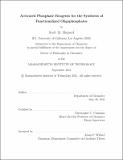Activated Phosphate Reagents for the Synthesis of Functionalized Oligophosphates
Author(s)
Shepard, Scott M.
DownloadThesis PDF (11.27Mb)
Advisor
Cummins, Christopher C.
Terms of use
Metadata
Show full item recordAbstract
Oligophosphates play essential roles in biochemistry, and considerable research has been directed towards the synthesis of both naturally occurring oligophosphates and their synthetic analogs. However, oligophosphates longer than triphosphates have been less well studied than shorter analogs. Here we have expanded the synthetic knowledge of these important compounds through the development of new reagents and methodologies for chemical oligophosphorylation. We developed and elaborated reagents for di-, tri-, and tetra- phosphorylation which react with a wide variety of nucleophiles to generate a library of oligophosphate products ranging from triphosphates to pentaphosphates. Furthermore, preliminary studies were undertaken to further elaborate the roles these oligophosphate play in biology.
Trimetaphosphate reacts with PyAOP ([(H₈C₄N)₃PON₄C5H₃][PF₆]), to yield an activated species, [P₃O₉P(NC₄H₈)₃] − isolated as its bis(triphenylphosphine)iminium (PPN) salt. Treatment of this activated trimetaphosphate with a variety of simple nucleophiles, such as alcohols and amines, generates nucleophile substituted trimetaphosphate products. The activated trimetaphosphate compound furthermore reacts with methylenetriphenylphosphorane to generate a trimetaphosphate based phosphorus ylide capable of P–C bond formation through Wittig chemistry. Ring opening of these substituted trimetaphosphate products with hydroxides results in linear triphosphate derivatives.
Adenosine and uridine 5′-tetra- and 5′-pentaphosphates were synthesized by treatment of the unprotected nucleosides or nucleoside monophosphates with an activated tetrametaphosphate ([PPN]₂ [P₄O₁₁]) and subsequent ring opening with hydroxide. These nucleotides were then tested for inhibition of the enzymatic activity of ribonuclease A. We then solved X-ray co-crystal structures of the highest affinity nucleotide binders to rationalize the increased binding affinity of longer nucleotides.
The anion [P4O₁₁] ²⁻, employed as its bis(triphenylphosphine)iminium (PPN) salt, was shown herein to be a versatile reagent for nucleophile tetraphosphorylation. Treatment with a nucleophile (amines, alcohols, phosphates, ylide, azide) yields a nucleophile substituted tetrametaphosphate intermediate that was then ring opened with a second nucleophile (hydroxide, amine, phenoxide, fluoride) to give a wide variety of tetra- and pentaphosphate derivatives.
Diphosphorylation of select nucleophiles was achieved by treatment with neutral, doubly zwiterrionic adducts of nucleophilic tertiary amines (pyridine, DABCO) and P₂O₅. The adducts were easily synthesized by reaction of the tertiary amine with polymeric phosphorus pentoxide in acetonitrile. The resulting adducts are competent diphosphorylation reagents, capable of generating unsymmetric dinucleoside tetraphosphates from nucleoside monophosphates or nucleoside tetraphosphates from nucleoside diphosphates.
Date issued
2021-09Department
Massachusetts Institute of Technology. Department of ChemistryPublisher
Massachusetts Institute of Technology